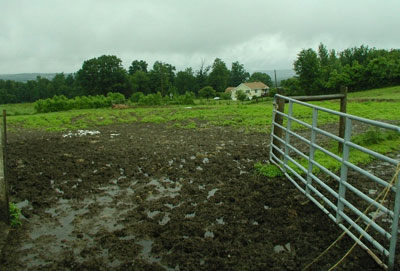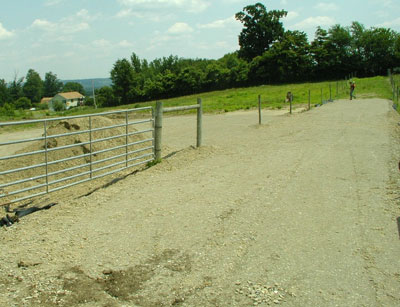Heavy Use Area Protection
In Crawford County, barnyards were typically located in the lowest part of the farm because it was near a water source. Unfortunately this proximity to water also makes for a muddy mess in the barnyard. Not only is this an environmental concern for those living downstream, but it is also a herd health concern. Muddy areas are breeding grounds for disease causing bacteria. The more livestock are exposed to these areas the more likely they will become ill. This means increased vet bills and decreased milk production for the farmer. The mud also makes day to day operation of the farm difficult, not to mention the wear and tear on equipment.

BEFORE: This is an example of a heavy use area where the livestock frequently enter and exit the barn.
How is it addressed?
There are four steps to stabilizing a heavy use area.
- Roof gutters are normally installed on the barn to direct water away from the barnyard.
- Drop boxes are installed above the barnyard to collect water before it has a chance to enter the barnyard. Then it is piped under the heavy use area into a grassy area to be dispersed.
- Geotextile (like a heavy feed bag material) is laid down across the barnyard. 12 inches of crushed bank is then placed on the geotextile. The gravel creates a stable area for the cattle and a solid surface for the farmer to scrape up and remove manure while the geotextile acts like a barrier to keep the gravel in place.
- Fencing is installed and paddocks are created so cattle can be rotated.

AFTER: Here is the same barnyard after construction. There is now a stable area for the livestock & the farmer.
Approximate Cost = $1.00 per square foot
The result is:
- A stable area for cattle
- Improved water quality
- Improved herd health
- Happy cows & happy downstream neighbors

